Nondestructive Wafer Level MEMS Piezoelectric Device Thickness Detection
Abstract
1. Introduction
2. Theory of Picosecond Laser Ultrasonics
2.1. Opaque Film
2.2. Transparent Film
3. Experimental Details
3.1. Experimental Setup
3.2. Description of the Sample
4. Experimental Results
4.1. Single-Layer Film
4.2. Double-Layer Composite Film
4.3. Standard Piezoelectric Composite Structure
4.4. Application on 8-inch Wafers
5. Conclusions
Author Contributions
Funding
Institutional Review Board Statement
Informed Consent Statement
Data Availability Statement
Conflicts of Interest
References
- Zhao, J.; Ge, M.; Lv, S.; Sun, H.; Song, C. Numerical investigation of an aln-based resonant detector with a plasmon aperture absorber for dual-band ir sensing. Electronics 2020, 9, 1264. [Google Scholar] [CrossRef]
- Zhu, M.; Shi, Q.; He, T.; Yi, Z.; Ma, Y.; Yang, B.; Chen, T.; Lee, C. Self-Powered and Self-Functional Cotton Sock Using Piezoelectric and Triboelectric Hybrid Mechanism for Healthcare and Sports Monitoring. ACS Nano 2019, 13, 1940–1952. [Google Scholar] [CrossRef] [PubMed]
- Liu, H.; Zhong, J.; Lee, C.; Lee, S.W.; Lin, L. A comprehensive review on piezoelectric energy harvesting technology: Materials, mechanisms, and applications. Appl. Phys. Rev. 2018, 5, 041306. [Google Scholar] [CrossRef]
- Zhu, Y.; Wang, N.; Sun, C.; Merugu, S.; Singh, N.; Gu, Y. A High Coupling Coefficient 2.3-GHz AlN Resonator for High Band LTE Filtering Application. IEEE Electron Device Lett. 2016, 37, 1344–1346. [Google Scholar] [CrossRef]
- Liu, C.; Zhu, Y.; Chen, B.; Wang, N. SC 0.15 Al 0.85 N-based 4 GHz Coupled Bulk Acoustic Resonators (CBAR) and Filters for the Single-Chip Duplexer Solution. In Proceedings of the 2021 IEEE International Ultrasonics Symposium (IUS), Xi’an, China, 11–16 September 2021. [Google Scholar]
- Gao, A.; Liu, K.; Liang, J.; Wu, T. AlN MEMS filters with extremely high bandwidth widening capability. Microsyst. Nanoeng. 2020, 6, 74. [Google Scholar] [CrossRef] [PubMed]
- Hongbin, Y.; Liang, L.; Yuandong, A.G. Capacitive micromachined ultrasonic transducer (CMUT) based micro viscosity sensor. Sens. Actuators B Chem. 2016, 227, 346–351. [Google Scholar] [CrossRef]
- Bi, F.Z.; Bradley, B.P. Bulk acoustic wave RF technology. IEEE Microw. Mag. 2008, 9, 65–80. [Google Scholar] [CrossRef]
- Lin, W.; Yun, X.; Wang, X.; Zeng, Z.; Wang, Y.; Zhang, X.; Zeng, C.; Zhang, B. Super-high sensitivity FBAR temperature sensor based on size effect of Ti insertion layer. Mater. Res. Express 2021, 8, 95701. [Google Scholar] [CrossRef]
- Aspnes, D.E.; Studna, A.A. High Precision Scanning Ellipsometer. Appl. Opt. 1975, 14, 220. [Google Scholar] [CrossRef]
- O’Keefe, M.A.; Buseck, P.R.; Iijima, S. Computed crystal structure images for high resolution electron microscopy. Nature 1978, 274, 322–324. [Google Scholar] [CrossRef]
- Honarvar, F.; Varvani-Farahani, A. A review of ultrasonic testing applications in additive manufacturing: Defect evaluation, material characterization, and process control. Ultrasonics 2020, 108, 106227. [Google Scholar] [CrossRef] [PubMed]
- Emery, P.; Devos, A.; Ancey, P. Picosecond Ultrasonics: The prefered tool for BAW characterization. In Proceedings of the 2008 IEEE Ultrasonics Symposium, Beijing, China, 2–5 November 2008; pp. 2205–2208. [Google Scholar] [CrossRef]
- Devos, A.; Emery, P.; Caruyer, G.; Ancey, P. An improvement of the picosecond ultrasonic technique based on a tunable laser: Application to bulk acoustic wave resonator characterizations. Proc.-IEEE Ultrason. Symp. 2006, 1, 564–567. [Google Scholar] [CrossRef]
- Mante, P.A.; Devos, A.; Raymond, G.; Morin, P.; Ancey, P. Comparison between picosecond ultrasonics and nanoindentation characterization in thin film. In Proceedings of the 2009 IEEE International Ultrasonics Symposium, Rome, Italy, 20–23 September 2009; pp. 2564–2567. [Google Scholar] [CrossRef]
- Thomsen, C.; Grahn, H.T.; Maris, H.J.; Tauc, J. Surface generation and detection of phonons by picosecond light pulses. Phys. Rev. B 1986, 34, 4129–4138. [Google Scholar] [CrossRef] [PubMed]
- Akhmanov, S.A.; Gusev, V.E. Laser excitation of ultrashort acoustic pulses: New possibilities in solid-state spectroscopy, diagnostics of fast processes, and nonlinear acoustics. Sov. Phys.-Uspekhi 1992, 35, 153–191. [Google Scholar] [CrossRef]
- Wright, O.B.; Kawashima, K. Coherent phonon detection from ultrafast surface vibrations. Phys. Rev. Lett. 1992, 69, 1668–1671. [Google Scholar] [CrossRef]
- Perrin, B. Investigation of Short-Time Heat Transfer Effects by an Optical Pump–Probe Method 1 Acoustic and Thermal Generation by Ultrashort Laser Pulse. Physics 2007, 359, 333–359. [Google Scholar]
- Matsuda, O.; Larciprete, M.C.; Voti, R.L.; Wright, O.B. Fundamentals of picosecond laser ultrasonics. Ultrasonics 2015, 56, 3–20. [Google Scholar] [CrossRef]
- Hu, X.; Xu, T.; Zhou, L.; Wang, Q.; Arıcı, M.; Li, D. Comparison of transmittance and reflection methods for solving optical constants of optical glass. Optik 2019, 183, 924–932. [Google Scholar] [CrossRef]
- Gusev, V.E.; Ruello, P. Advances in applications of time-domain Brillouin scattering for nanoscale imaging. Appl. Phys. Rev. 2018, 5, 031101. [Google Scholar] [CrossRef]
- Lomonosov, A.M.; Ayouch, A.; Ruello, P.; Vaudel, G.; Baklanov, M.R.; Verdonck, P.; Zhao, L.; Gusev, V.E. Nanoscale noncontact subsurface investigations of mechanical and optical properties of nanoporous low-k material thin film. ACS Nano 2012, 6, 1410–1415. [Google Scholar] [CrossRef]
- Chenguang, H. Brillouin studies of surface acoustic waves in nanostructured phononic crystals. National University of Singapore: Singapore, 2015. [Google Scholar]
- Ruello, P.; Gusev, V.E. Physical mechanisms of coherent acoustic phonons generation by ultrafast laser action. Ultrasonics 2015, 56, 21–35. [Google Scholar] [CrossRef] [PubMed]
- Wang, W.; Mayrhofer, P.M.; He, X.; Gillinger, M.; Ye, Z.; Wang, X.; Bittner, A.; Schmid, U.; Luo, J.K. High performance AlScN thin film based surface acoustic wave devices with large electromechanical coupling coefficient. Appl. Phys. Lett. 2014, 105, 133502. [Google Scholar] [CrossRef]
- Li, M.; Xie, J.; Chen, B.; Wang, N.; Zhu, Y. Microstructural evolution of the abnormal crystallite grains in sputtered ScAlN film for piezo-MEMS applications. IEEE Int. Ultrason. Symp. IUS 2019, 2019, 1124–1126. [Google Scholar] [CrossRef]
- Hansen, C.H. Fundamentals of acoustics. In Occupational Exposure to Noise: Evaluation, Prevention and Control; World Health Organization: Geneva, Switzerland, 2001; Volume 1, pp. 23–52. [Google Scholar]
- Kaye, G.W.C. Tables of Physical and Chemical Constants and Some Mathematical Functions; Nabu Press: Charleston, SC, USA, 2015. [Google Scholar]
- Ichihashi, H.; Yanagitani, T.; Suzuki, M.; Takayanagi, S.; Matsukawa, M. Effect of Sc concentration on shear wave velocities in ScAlN films measured by micro-Brillouin scattering technique. In Proceedings of the 2014 IEEE International Ultrasonics Symposium, Chicago, IL, USA, 3–6 September 2014; pp. 2521–2524. [Google Scholar] [CrossRef]
- Kim, H.; Kim, C.; Yu, M.; Kim, H.S.; Blick, R.H. Local etch control for fabricating nanomechanical devices. J. Appl. Phys. 2010, 108, 7–10. [Google Scholar] [CrossRef]
- Cui, B. (Ed.) Recent advances in nanofabrication techniques and applications. In Recent Advances in Nanofabrication Techniques and Applications; IntechOpen: London, UK, 2011. [Google Scholar]


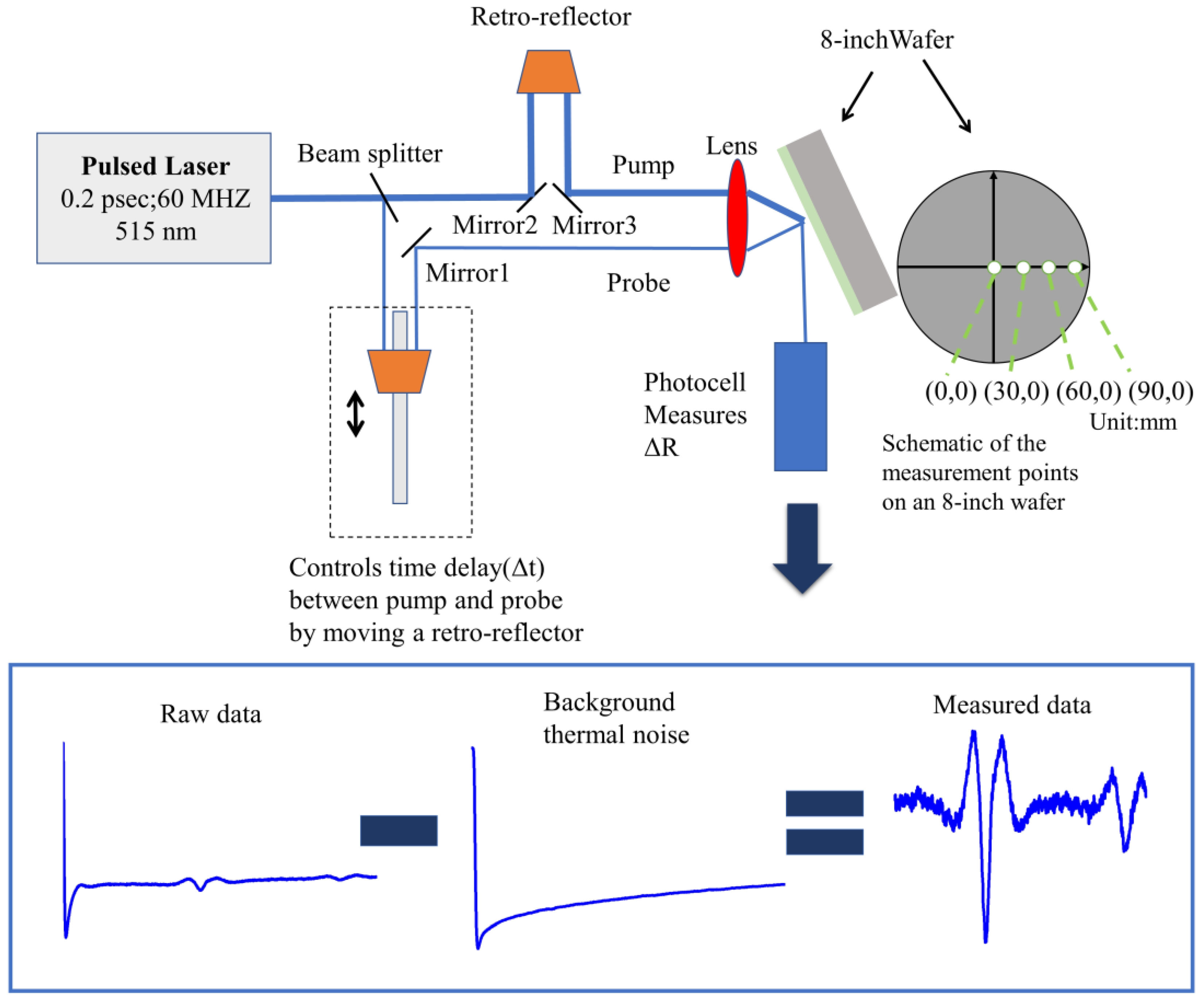
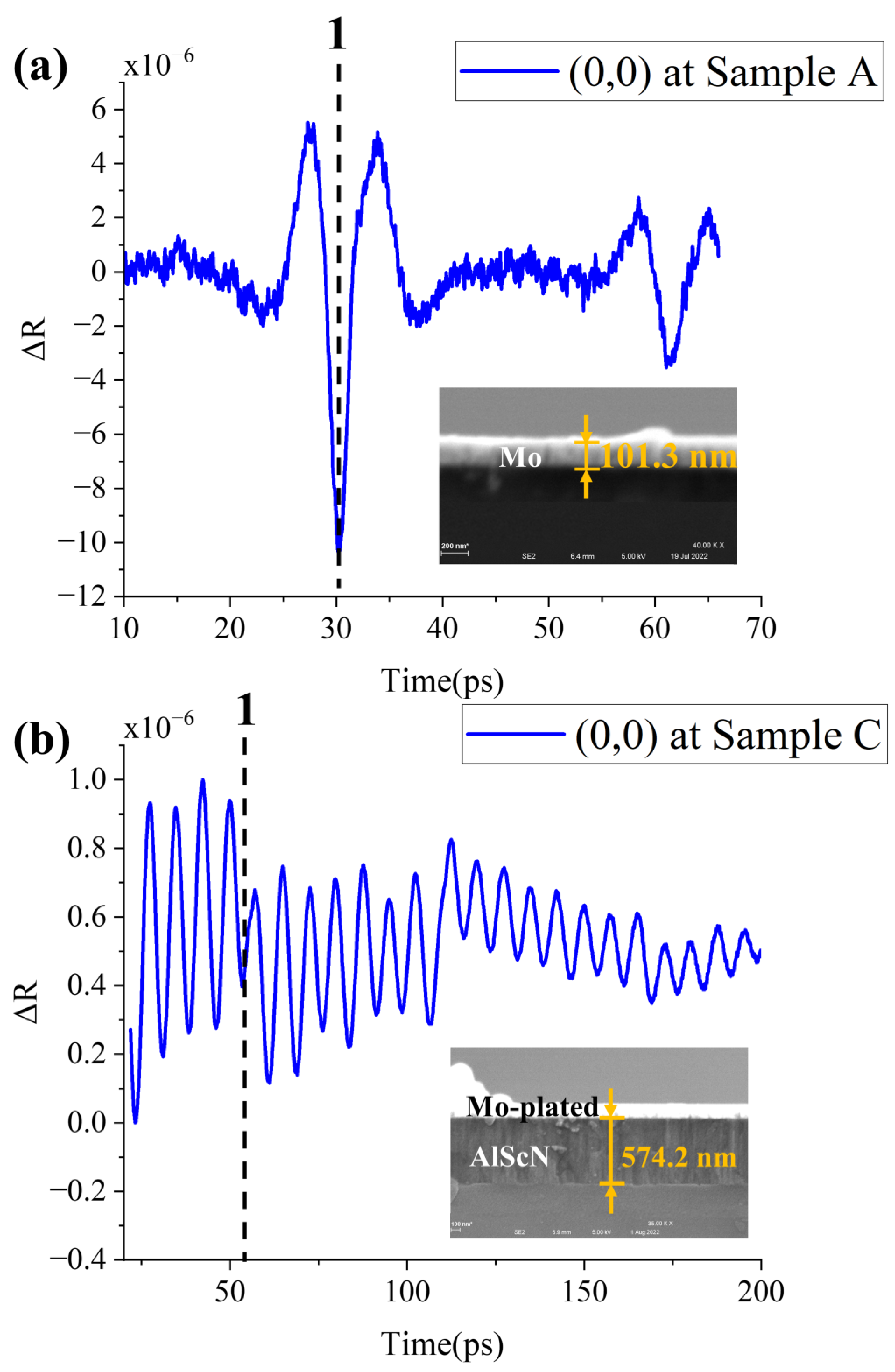
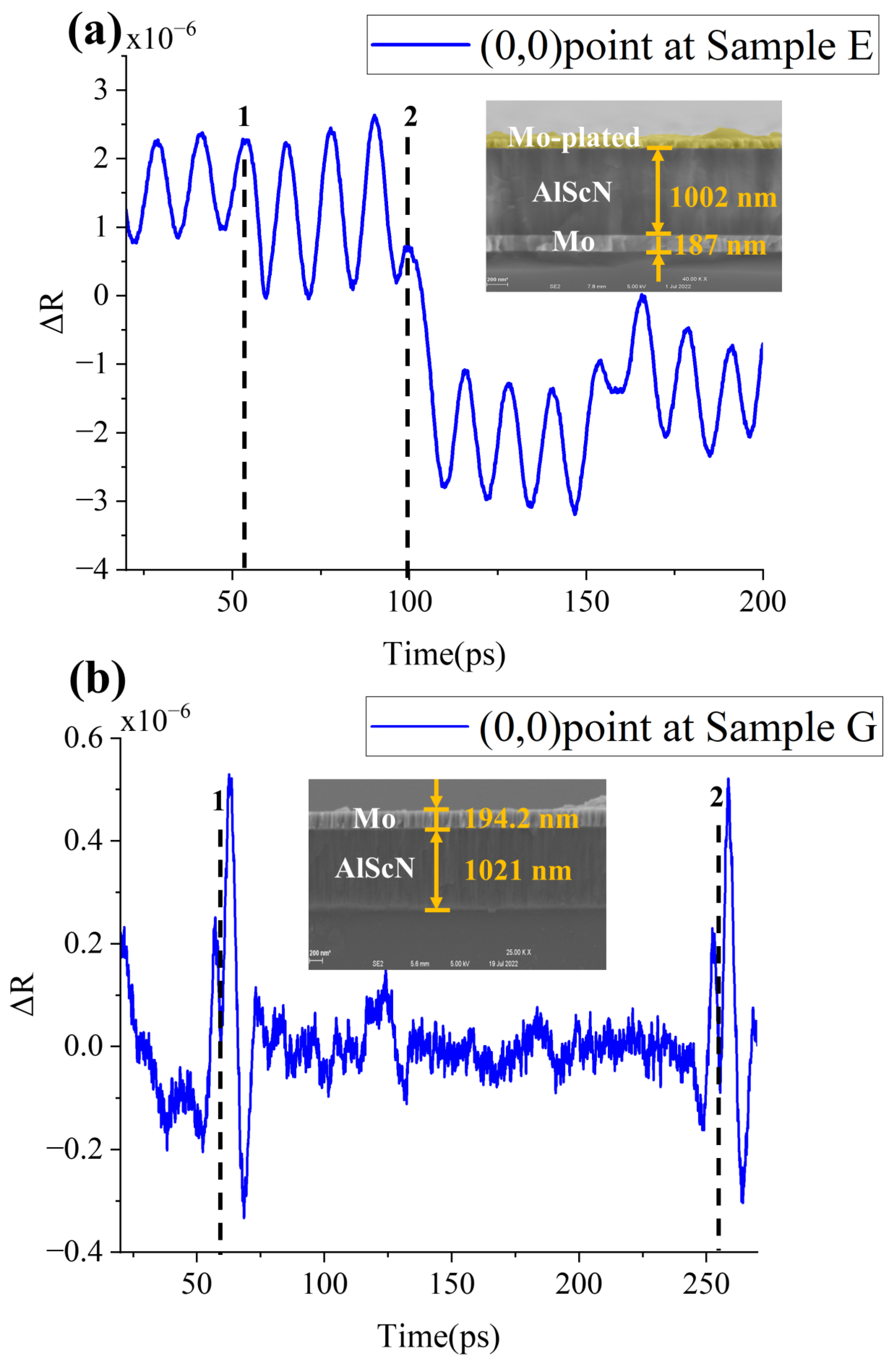
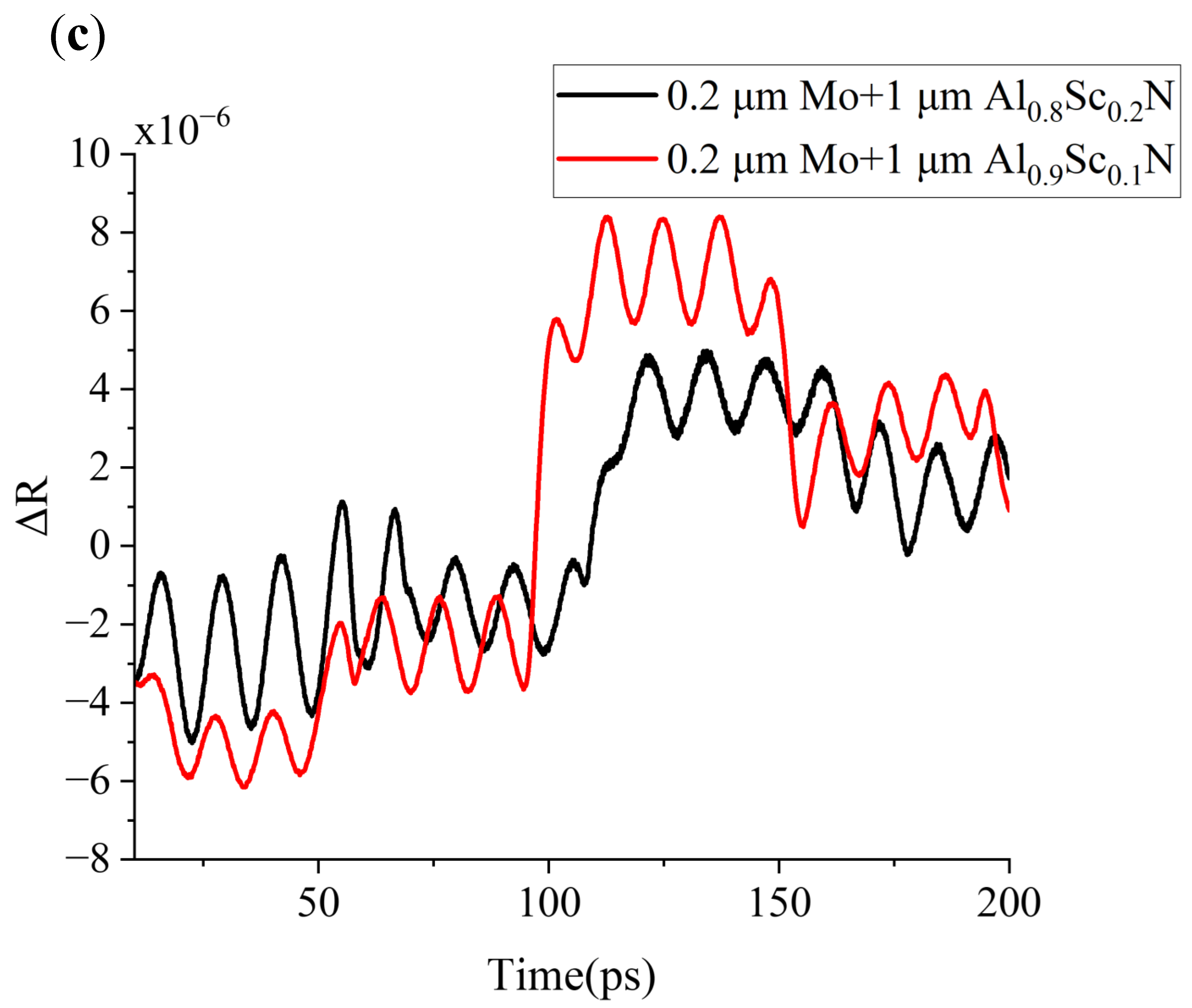
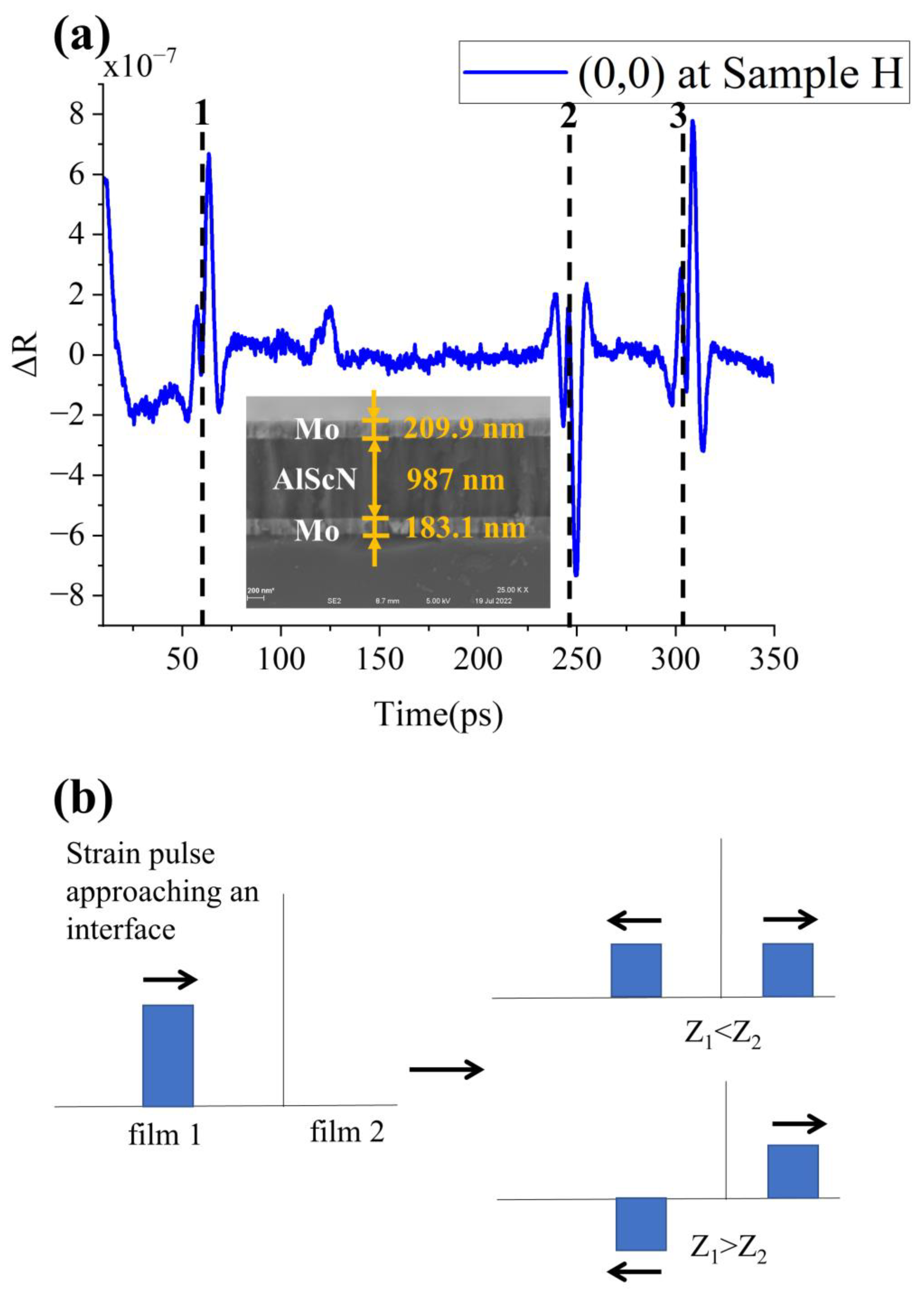
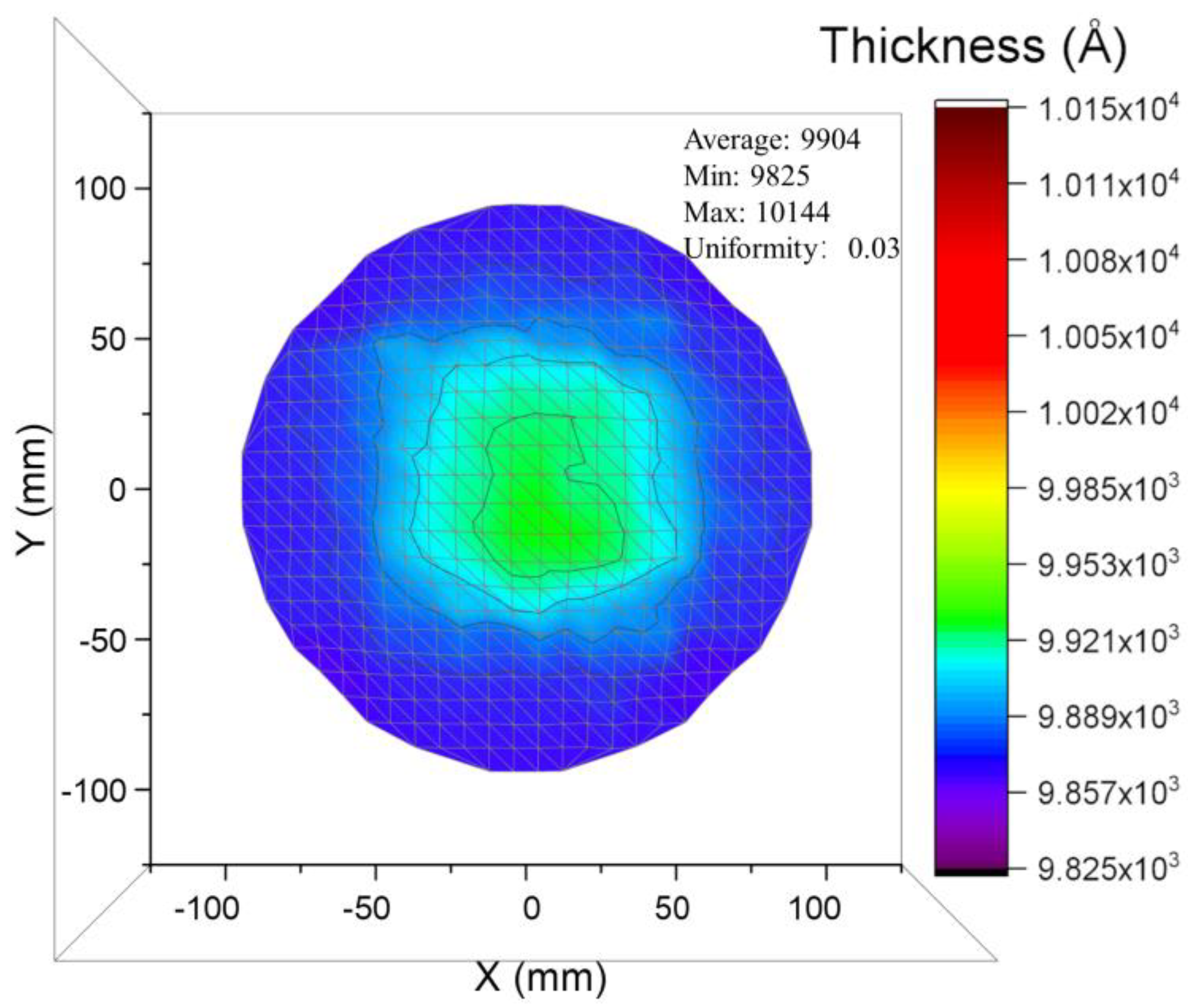
| Sample | Structure |
|---|---|
| A | 0.1 μm Mo |
| B | 0.3 μm Mo |
| C | 0.6 μm Al0.9Sc0.1N |
| D | 1 μm Al0.9Sc0.1N |
| E | 0.2 μm Mo + 1 μm Al0.9Sc0.1N |
| F | 0.2 μm Mo + 1 μm Al0.8Sc0.2N |
| G | 1 μm Al0.9Sc0.1N + 0.2 μm Mo |
| H | 0.2 μm Mo + 1 μm Al0.9Sc0.1N + 0.2 μm Mo |
| (0,0) * | (30,0) | (60,0) | (90,0) | Consistency | ||
|---|---|---|---|---|---|---|
| A | picosecond ultrasound | 998 | 1028 | 1009 | 976 | 99% |
| SEM | 1013 | 1005 | 1021 | 966 | ||
| B | picosecond ultrasound | 2920 | 2962 | 2927 | 2838 | 99% |
| SEM | 2880 | 2941 | 2903 | 2854 | ||
| C | picosecond ultrasound | 5777 | 5819 | 5582 | 5512 | 99% |
| SEM | 5742 | 5901 | 5678 | 5614 | ||
| D | picosecond ultrasound | 10,006 | 9685 | 9699 | 9672 | 99% |
| SEM | 10,020 | 9666 | 9622 | 9634 | ||
| E | picosecond ultrasound | 1884/10,024 | 1820/10,265 | 1730/9945 | 1628/9807 | 98%/98% |
| SEM | 1870/10,020 | 1786/10,080 | 1719/9769 | 1658/9881 | ||
| F | picosecond ultrasound | 1940/10,143 | 1922/9989 | 1934/9874 | 1907/9807 | 98%/98% |
| SEM | 1926/10,103 | 1877/9881 | 1964/9639 | 1910/9742 | ||
| G | picosecond ultrasound | 10,249/1965 | 9826/1997 | 9771/1978 | 9958/1906 | 98%/98% |
| SEM | 10,210/1942 | 9781/1786 | 9602/2010 | 9915/1876 | ||
| H | picosecond ultrasound | 2077/10,003/1935 | 2114/9886/1985 | 1960/9760/1966 | 1905/9681/1911 | 98%/99%/98% |
| SEM | 2099/9870/1831 | 2188/9781/1965 | 1920/9691/1997 | 1954/9647/1876 |
Publisher’s Note: MDPI stays neutral with regard to jurisdictional claims in published maps and institutional affiliations. |
© 2022 by the authors. Licensee MDPI, Basel, Switzerland. This article is an open access article distributed under the terms and conditions of the Creative Commons Attribution (CC BY) license (https://creativecommons.org/licenses/by/4.0/).
Share and Cite
Zhou, Y.; Gu, Y.; Zhang, S. Nondestructive Wafer Level MEMS Piezoelectric Device Thickness Detection. Micromachines 2022, 13, 1916. https://doi.org/10.3390/mi13111916
Zhou Y, Gu Y, Zhang S. Nondestructive Wafer Level MEMS Piezoelectric Device Thickness Detection. Micromachines. 2022; 13(11):1916. https://doi.org/10.3390/mi13111916
Chicago/Turabian StyleZhou, Yongxin, Yuandong Gu, and Songsong Zhang. 2022. "Nondestructive Wafer Level MEMS Piezoelectric Device Thickness Detection" Micromachines 13, no. 11: 1916. https://doi.org/10.3390/mi13111916
APA StyleZhou, Y., Gu, Y., & Zhang, S. (2022). Nondestructive Wafer Level MEMS Piezoelectric Device Thickness Detection. Micromachines, 13(11), 1916. https://doi.org/10.3390/mi13111916






